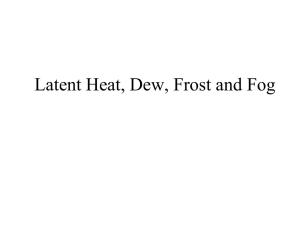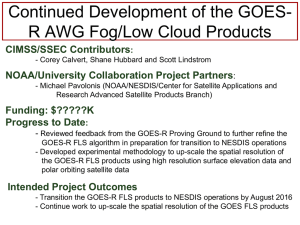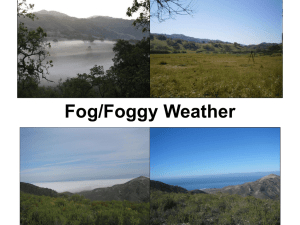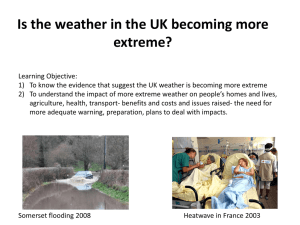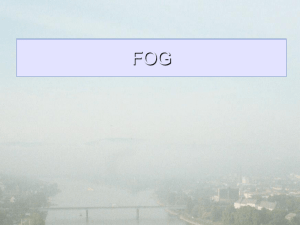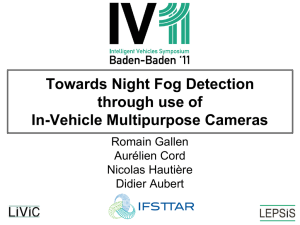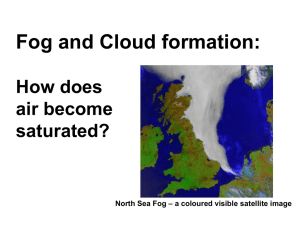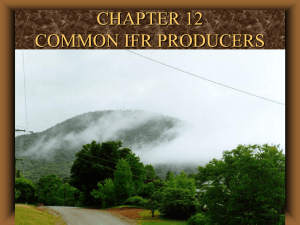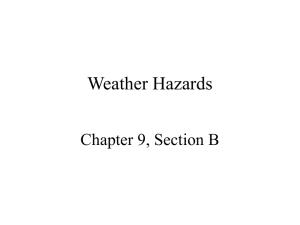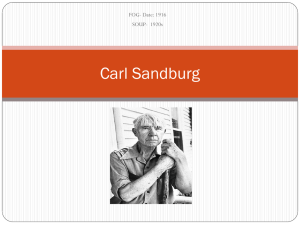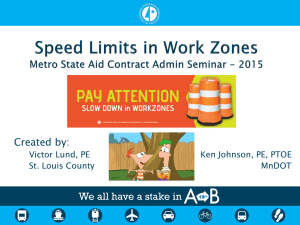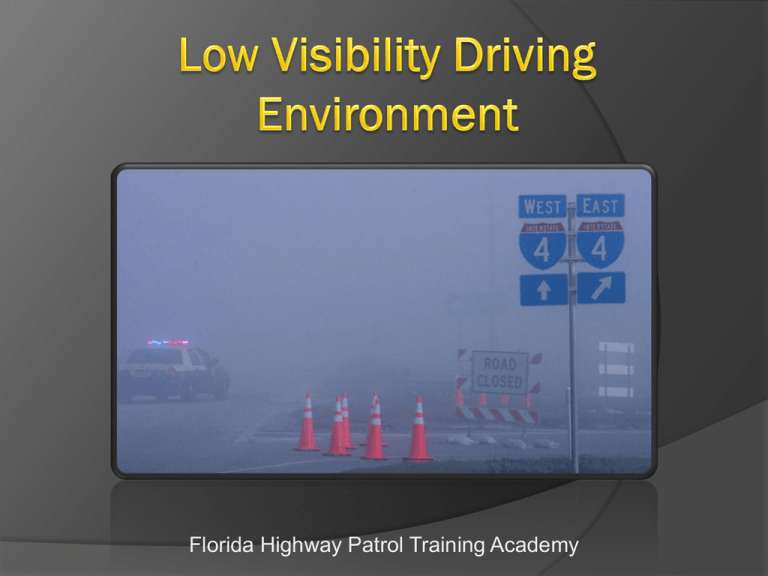
Florida Highway Patrol Training Academy
Smoke
Fog
“Superfog”
- Smoke and
Fog mixture
Heavy rain and wind
Fog forms when water evaporates
from a surface or is added to the air.
As water begins to it rises into the air. Water vapor
rises and bonds with small dust particles in the air).
These droplets form fog when the process occurs
close to the ground.
Several conditions that need to first:
relative humidity is near 100%
air temperature and dew point temperature are close to
one another or less than 4˚F (2.5˚C).
Source: ©2012 About.com. All rights reserved - http://geography.about.com/od/waterandice/a/fog-overview.htm
Super fog is a combination of smoke and fog
Smoke and ash from a burn mix with the humidity in the air
Super fog can form as an almost solid wall with visibility reduced to near
zero.
While it most often forms at night, it is usually at its heaviest in the early
morning hours before the heat of the sun can burn it off.
It is present most often during the morning rush hour.
It is almost impossible for weather forecasters and scientists to predict.
Super fog can form more than 20 to 30 miles away from the site of the fire.
Source: ©20121National Safety Commission Inc. All rights reserved - http://alerts.nationalsafetycommission.com/2011/06/super-fog-tips-for-dealing-with.html
Super fog in
Putnam County,
Jan 2012, SR 20
east of
Gainesville 1
month before the
I-75 crashes
10 feet from Patrol Car
20 feet from Patrol Car
30 feet from Patrol Car
Reduced
visibility
Hydroplaning
risk
Loss of
traction
Before entering an interstate for a night time or early morning
commute, listen to local news, weather, and traffic reports. If there are
reports of a wild fire or foggy conditions in your local area, consider
taking an alternate route and avoid high-speed roadways altogether.
If you are on an interstate, watch for electronic or "fold-out" signs
warning of fog ahead.
In foggy conditions, SLOW DOWN! Most of the major pile-ups
occurred because drivers didn’t slow down and, once it was too late,
they couldn’t stop in time to avoid hitting a slow or stalled vehicle
ahead.
Do not use your bright beams. The high beams of your bright lights will
reflect off the fog causing increased glare. Use low beams only.
The lack of any visual references while driving in fog can make it seem
like you are going slower than you actually are. Pay attention to your
speedometer and REDUCE YOUR SPEED!
Avoid lane changes. If you are unable to avoid a lane change, use extra caution
before moving over and always use your turn signals.
Roll down the driver's side window and listen for anything unusual that can warn you
of a problem up ahead.
Do not use your cell phone while driving or engage in any other distracting activities
such as eating or playing the radio too loudly. Concentrate 100% on the road
conditions around you as far as you possibly can.
Scan your rear view mirrors for warning of vehicles behind that may be approaching
too fast.
If you are approaching an exit, exit the roadway and use an alternate route.
If, for any reason, you have to stop, pull off the roadway as far as you possibly can
and activate your emergency blinkers. Once you are off the roadway, get out of your
vehicle and walk as far away from the roadway as you can. Once you are safely out
of your car, you should use your cell phone to call the police or highway patrol and
alert them to the conditions.
Source: ©20121National Safety Commission Inc. All rights reserved - http://alerts.nationalsafetycommission.com/2011/06/super-fog-tips-fordealing-with.html
PRT is defined as the interval between the
appearance of some object or condition in the
driver’s field of view and the initiation of a
response.
If conditions are perfect, the generally
accepted PRT is approximately 1.6 seconds
This does not take into account the
mechanical delay, which is the time between
when the driver initiates a response and when
the vehicle reacts (brakes actually engage,
wheels actually turn, etc.)
Using a perfect world with an undistracted driver with
good PRT (1.6 seconds), a vehicle with 100% braking,
a good traction/friction (0.71 drag factor), let’s
calculate approximate stopping distances:
SPEED
70 mph
65 mph
60 mph
55 mph
50 mph
45 mph
40 mph
Stopping Distance
394 feet
350 feet
309 feet
271 feet
234 feet
200 feet
168 feet
If not on the scene of the incident, proceed immediately to the
scene so that you can begin to evaluate the situation and take
charge as Incident Commander until properly relieved of that
responsibility by a member of higher rank;
Notify RCC and provide as much pertinent information as
possible to the Regional Duty Officer so that the CAD
incident can be updated (i.e., exact location to include grid
coordinates if possible, size of the area affected, presence of
fog, smoke or both, proximity of fire, low lying areas,
proximity of rivers/lakes/ponds, wind strength and direction,
traffic conditions, etc.);
Attempt to personally notify an on-duty district supervisor
and/or Troop Watch Supervisor (TWS) of any major
smoke/fog incidents that could lead to significant road
closures
If unable to personally make notification, direct the
Regional Duty Officer to notify an on-duty district
supervisor and/or Troop Watch Supervisor (TWS)
Ensure the Regional Duty Officer documents the
notifications or attempted notifications in the CAD
notes
If unsure that supervisory notification is needed, a
supervisor will be notified
If there is an immediate risk to the safety of the
public due to smoke/fog, then immediately attempt to
close the roadway if it can be done safely and
without jeopardizing your safety
Activate all patrol car emergency lights and set up
traffic cones/fusees if available;
Put on your high visibility traffic safety vest, and take
appropriate action to safeguard the public.
When appropriate and authorized, restore the normal,
orderly flow of traffic;
Monitor the situation and provide timely updates to the
on-duty district supervisor and/or TWS, and respective
RCC;
Remain at your post until properly relieved or authorized
to leave by higher authority.
Ensure Trooper is dispatched to the location;
Notify other FHP units (as appropriate);
Notify Florida Forest Service;
Notify Troop Watch Supervisor;
Notify on-duty District Lieutenant(s) and
Sergeant(s);
Obtain a spot weather forecast for the affected area
from the National Weather Service;
Identify current or overnight LVORI levels to
determine risk of high LVORI 7 or greater;
Ensure detour routes established;
Confirm staffing plan is in place to monitor location
& close roadway if needed;
Ensure safety of the public prior to re-opening of the
roadway and monitor as needed;
Notify local law enforcement agencies
Notify FDOT of possible road closures and
signage request (if appropriate);
Notify Public Affairs Officer and/or Media;
Notify State Warning Point;
Ensure completion and distribution of the press
release and entries in the FHP Notification and
Reporting System;
Ensure all information concerning incident is
entered into CAD.
Ensure Trooper is dispatched to the location, if
appropriate;
Notify other FHP units (as appropriate);
Notify local law enforcement agencies; request
assistance as needed;
Notify FDOT, if needed;
Determine detour routes and availability of detour
signs;
Determine the availability of warning
signs/barricades and consider staging in case of
need;
Consider roadway characteristics/obstructions – if
obstructed due to traffic crash, activate Rapid
Incident Scene Clearance (RISC) if available;
Consider distance of visibility; weather
conditions/warnings/advisories (with fog, consider
time of day & year);
Consider other ambient conditions present –
wildfires, smoke, temperature, hazmat, etc.;
Geographic considerations / hazard proximately
(potential for dense fog to mix with localized smoke
from prescribed burns or wildfires)
Obtain a spot weather forecast and/or LVORI, if
appropriate;
Consider traffic density and the occurrence or
possibility of secondary collisions;
Ensure the safety of the public prior to re-opening
the roadway and monitor as needed;
Notify Public Affairs Officer and/or Media;

